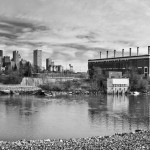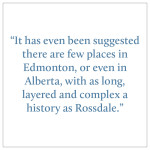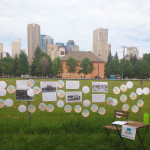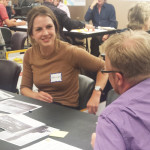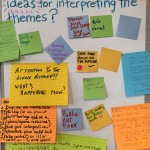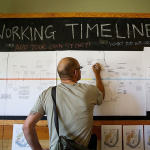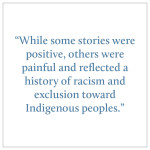On July 11, 2017, City Council approved a plan for preserving and sharing the history of Rossdale, a place at the heart of not only Edmonton’s landscape, but also its historic narrative. Olive Bailey is a Principal Planner with the City Planning Branch at the City of Edmonton and leads the Heritage Interpretive Plan for the River Crossing Initiative. In this guest post, Olive describes the community work that went into building the Heritage Interpretive Plan and some of the lessons from this lengthy learning process.
Over the past year, the City of Edmonton has been working on a Heritage Interpretive Plan for the River Crossing or West Rossdale area.
The Heritage Interpretive Plan builds on previous studies and knowledge about the area, but is in many ways still a starting point for answering the questions about why this place is important and how we should communicate that importance to people.
The main aim of this plan is to set the stage for honouring and celebrating the rich heritage of the River Crossing area in ways that are authentic and compelling for the different people who will use the space. The plan also serves as an important building block for the River Crossing project, which seeks to redevelop the West Rossdale area into a vibrant community and special place for Edmontonians that honours the area’s rich history.
The River Crossing area is at the heart of our city and is both historically and culturally significant for many people and communities, including Indigenous and Settler communities. It has even been suggested there are few places in Edmonton, or even in Alberta, with as long, layered and complex a history as Rossdale. To many within Edmonton’s heritage community, the historical significance of Rossdale area is well-known, but this history is not as well known to many Edmontonians.
- 100in1Day in Rossdale. Photo by Hani Quan
Some aspects of that history are visible in the area today through tangible, physical elements such as the Traditional Burial Grounds and Fort Edmonton Cemetery, Rossdale Generating Station, and Ortona Armoury. Other stories, we know through written documents and photographs. These sites, buildings and documents, however, tell only a few stories about this place and they do so from a limited set of perspectives, namely those of prominent Settlers.
As the team at the City of Edmonton leading the Heritage Interpretive Plan for the West Rossdale area, we recognized that understanding the history of the area meant revisiting the narrative and expanding the conversation to be able to hear those stories and start to understand those missing perspectives.
To do this we knew we had to hear from the people with a connection to this special place. We reached out to Edmontonians, Indigenous communities, heritage organizations and subject matter experts. We went out to the community and attended events to tell people about the project. We partnered with organizations and existing programs to invite people to the area to learn and talk about the area’s layered past. For instance, we organized walking tours as part of Jane’s Walk and Edmonton District Historical Society’s Doors Open festival, a Pop-Up Museum in collaboration with the Edmonton Heritage Council’s Edmonton City as Museum Project, and a Let’s Talk panel discussion in collaboration with the Edmonton Heritage Council and City-Region Studies Centre. We also invited interested people and stakeholders into formal dialogue about the importance and history of the River Crossing area through workshops, open houses and surveys.
We also heard from Indigenous communities, reaching out to 29 First Nation and Metis communities and related organizations. We met with communities to better understand how to engage with them on this type of project, and then created opportunities, including site visits and workshops with Elders, that tailored to the needs of the communities.
- Public Visioning Workshop. Photo by Deeksha Choudhry.
- Validation Workshop. Photo by Marco Melfi.
- Visioning Workshop. Photo by John DeWolfe.
Over the past year and a half, we heard many stories told in different ways. While some stories were positive, highlighting progress, innovation, relationship-building, and milestones in Edmonton and Alberta’s history, others were painful and reflected a history of racism and exclusion toward Indigenous peoples.
Many stories were specific to Rossdale and some were broader and connected to the history of Edmonton and Canada. We heard about personal and community connections, memories, feelings, facts, research, hypotheses, aspirations, as well as ideas and concerns related to interpretation. We heard about the importance of acknowledging Indigenous and Settler perspectives and connections; creating opportunities for communities to tell their stories in their own words; basing future interpretation on reliable research and oral history; using different media and activities to tell stories in ways that are relatable and accessible; and leveraging the river and historic resources to interpret history.
- ECAMP at River Crossing Open House
The input we received through this process was used to create a thematic framework, in this case a set of four linked interpretive themes and goals. In the Heritage Interpretive Plan, we explore this thematic framework through a series of ideas for interpreting the themes and stories through materials, events, activities, architecture, urban design, media and public art. Many of these ideas also came out of engagement as did many of the principles for moving forward with heritage interpretation. The entire final draft of the River Crossing Heritage Interpretive Plan, can be found at Edmonton.ca/HeritageInterpretivePlan.
As we worked on the plan, it became clear that although the Heritage Interpretive Plan builds on previous work and knowledge, it is still very much a starting point for understanding the history of the area from different perspectives and for learning how to move forward with sharing those stories in ways that are compelling, authentic and appropriate. It also became clear that telling the stories is not something that the City can or should do alone. It will require collaboration between partners, Edmontonians, Indigenous communities, heritage practitioners, local organizations, designers and other implementers.
On July 11, 2017, Edmonton City Council approved the River Crossing Heritage Interpretive Plan. This means that we can now turn our attention to implementing the plan with partners and the community through tactical interpretation and events to begin to tell the stories of this place in the short term. Council’s approval also firmly establishes the Heritage Interpretive Plan as a foundation for redevelopment planning of the area to ensure that the heritage of this special place is honoured, shared and made visible as the area changes over time.
